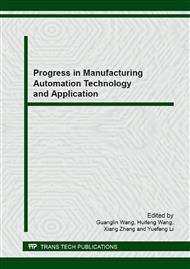[1]
H. Hertz: Journal für die reine und angewandte Mathematik. Vol. 92 (1882). pp.156-171. (In German).
DOI: 10.1515/9783112342404-004
Google Scholar
[2]
K. L. Johnson: Contact Mechanics (Cambridge University Press, UK 1985).
Google Scholar
[3]
G. G. Adams and M. Nosonovsky: Tribology International, Vol. 33 (2000), p.431–442.
Google Scholar
[4]
J. A. Greenwood and J. B. P. Williamson: Proceedings of the Royal Society of London Series A, Vol. 295 (1966) No. 1442, pp.300-319.
Google Scholar
[5]
J. A. Greenwood and J. H. Tripp: Proceedings of the Institution of Mechanical Engineers, Vol. 185 (1970) No. 1625, p.633.
Google Scholar
[6]
J. I. McCool: Journal of Tribology, Vol. 122 (2000) No. 3, p.496.
Google Scholar
[7]
A. Polycarpou and I. Etsion: Journal of Tribology, Vol. 121 (1999) No. 2, p.234.
Google Scholar
[8]
R.L. Jackson and I. Green: Transactions of the ASME-F-Journal of Tribology, Vol. 127 (2005) No. 2, p.343.
Google Scholar
[9]
Y. Zhao, Y. Lu and J. Jiang: Chinese Journal of Mechanical Engineering, Vol. 43 (2007) No. 3, p.95. (In Chinese).
Google Scholar
[10]
R. S. Sayles and T. R. Thomas: Nature, Vol. 271 (1978), p.431.
Google Scholar
[11]
Y. Morag and I. Etsion: Wear, Vol. 262 (2007) No. 5, p.624.
Google Scholar
[12]
J. F. Archard: Proceedings of the Royal Society of London Series A, Vol. 243 (1957) No. 1233, p.190.
Google Scholar
[13]
A. Majumdar and B. Bhushan: Journal of Tribology, Vol. 112 (1990) No. 2, p.205.
Google Scholar
[14]
A. Majumdar and B. Bhushan: Journal of Tribology, Vol. 113 (1991) No. 1, pp.1-11.
Google Scholar
[15]
L. Kogut and I. Etsion: Journal of Applied Mechanics, Vol. 69 (2002), p.657.
Google Scholar
[16]
L. Kogut and I. Etsion: Tribology Transactions, Vol. 46 (2003) No. 3, p.383.
Google Scholar
[17]
S. Kucharski, T. Klimczak, A. Polijaniuk and J. Kaczmarek: Wear, Vol. 177 (1994), pp.1-13.
DOI: 10.1016/0043-1648(94)90112-0
Google Scholar
[18]
L. Pei, S. Hyun, J.F. Molinari and M. O. Robbins: Journal of the Mechanics and Physics of Solids, Vol. 53 (2005) No. 11, p.2385.
Google Scholar
[19]
U. Sellgren, S. Björklund and S. Andersson: Wear, Vol. 254 (2003), p.1180.
Google Scholar
[20]
V. A. Yastrebov, J. Durand, H. Proudhon and C. Georges: Comptes Rendus Mecanique, Vol. 339 (2011) No. 7, p.473.
Google Scholar
[21]
S. Ge and S. Suo: Tribology, Vol. 17 (1997) No. 4, p.354. ( In Chinese).
Google Scholar
[22]
S. Ge and K. Tonder: Tribology, Vol. 17 (1997) No. 1, p.73. (In Chinese).
Google Scholar


